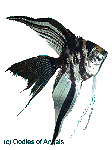

Common Name: Angelfish
Scientific Name: Pterophyllum scalare
Category: Genus of the Cichlidae but with few species.
Origins: Native to tropical South America. The river basins of the
Orinoco and the Amazon.

Description: The body is compressed like a disc and very tall. The
caudal and anal fins are also very elongated, so that the fish looks
triangular. The ventral fin is also very long, bent like a saber. A
gleaming silver color with black slanting bands, the one between the dorsal
and anal fins being the widest. Grows up to a length of 6 inches (15cm).
Environment: Should be kept in large, tall tanks with plenty of vegetation
that should reach up to the water surface. Large-leafed water plants, such
as Echinodorus and Giant Vallisnerias (Vallisneria gigantea)
are most suitable. The substrate can be fine-grained, as the members of
the genus Pterophyllum do not stir it up, as they are a very peaceable
genus and the fish move calmly around the tank. The water should be soft
at a temperature between 72 to 86F (22-30C). Frequent partial water changes
is advisable. Community tank.
Diet: Worms, crustaceans, insects, plant matter, dried food.
Tank Mates: Kissing gourami Helostoma temmincki, Black neon
tetra Hyphessobrycon herbertaxelrodi, Black
ghost knifefish Apteronotus albifrons, Albino cory
Corydoras aeneus, Panaque suttoni. (Let me know what
you have!)
Breeding: Breeding shouldn't be a problem, provided both fish are
healthy. It is best to just let a pair select each other, because if
they are forced upon one another they do not always get along. This pair
may stay together as mates for years. It is also not easy to tell the sexesapart.
The likely place for them to chose to spawn would be large aquatic plant
leaves (preferably the Parlor Palm, Aspidistra elatior) and occasionally
rocks or wood. After they clean the spot, the female will attach the spawn
granules one at a time, and then the male will come behind and fertilize
them. The female may lay up to 1,000 eggs. Both parents take part in caring
for the eggs. They will take turns fanning water over them, removing "bad"
eggs and also helping the fry escape from the egg-case. The hatching takes
place in 1-2 days.
The fry are then spit out onto a leaf, where they are attached by a
thread secreted from a gland on the head. They will stay there for awhile,
after which they will be taken to shallow hollows in the substrate. After
about 4 to 5 days the fry will begin to try to swim and the parents will
lead them through the tank. Occasionally the fry will be eaten, especially
if the parents are disturbed.
You can also play it safe and hatch the eggs yourself . A larger sized
aquarium is best for this, at least 20 gallons. The water should be neutral
to slightly acid and at a temperature of about 78F. Have the tank bare with
the exception of a 2 inch wide strip of acrylic resting at an angle against
the side. The female will usually spawn against any vertical surface and
has even been known to try to lay eggs on her mate. After the eggs are finished
being layed and fertilized, remove them to a separate tank. Agitate the water
slightly near them with an airstone, and remove any eggs that turn white
with an eye-dropper.
About 4 or 5 days after hatching, the fry have absorbed their yolk-sacs
and will begin an active search for food. You can feed them hard boiled egg
yolk that has been squeezed through cloth. Or you can also feed them freeze
dried fry food. After a bit they will be able to be fed newly hatched, "baby"
brine shrimp.